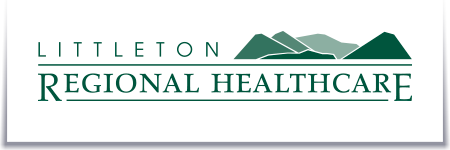Although Littleton Regional Healthcare’s Emergency Medical Services (EMS) system is “state of the art” today, this system had a humble beginning in the late 1950s. In the early days, these pre-hospital services operated alongside Littleton Hospital to give patients who were injured or extremely sick a better chance to recover fully. Over the years, both hospital and pre-hospital emergency services have matured to the great organizations we know today. The physicians, nurses, ambulance drivers, first responders, public safety professionals, dispatchers, and EMS providers are a closely knit community, always keeping the welfare of the patients first.
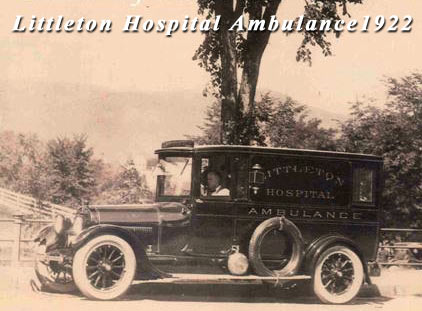
Littleton Hospital’s first motor ambulance was a donation from Mr. and Mrs. Alvin Ivie of New York City and Bethlehem in 1922. This ambulance (pictured) replaced a horse drawn vehicle. The charges for ambulance calls were $3.00 within the Littleton Village District and 20 cents per mile outside of the District, with a minimum charge of $5.00. The hospital superintendent directed the operation of the ambulance service.
One of the early pioneers in Emergency Medicine, not only in the North Country but worldwide, was Dr. Harry McDade, General Surgeon. He joined the Littleton Hospital staff in 1958 when the evolution of Emergency Medicine was just starting across the country. Dr. McDade was involved nationally and regionally. In using his expertise, he established Littleton to be on the cutting edge of developments in Emergency Medicine and Trauma.
Another important player in the evolution of Emergency Medicine in the Littleton area was Tom Ross, a native of Littleton, NH. Tom graduated from Littleton High School in 1959. After that, he spent six years as a ski patroller at Cannon and Mittersill Mountains in Franconia, NH. In this role, Tom witnessed and participated in rescuing and caring for skiers involved in accidents on the mountain. His years as a professional ski patroller inspired Tom to greater work in the area of pre-hospital care of the injured.
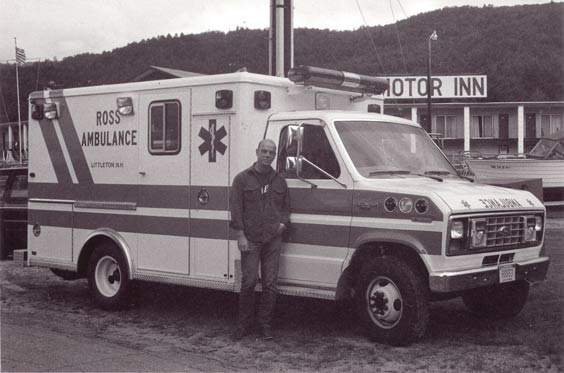
Tom graduated from Boston University with a degree in Biology, and furthered his studies in Mortuary Science, becoming a funeral director. As an apprentice in Hanover, NH, part of Tom’s job was to travel by hearse to medical and surgical emergencies in the area. Before the days of private ambulance services, undertakers were the only ones with vehicles for safely transporting patients to the hospitals. In the 1960s, those involved in pre-hospital care had almost no equipment to keep the injured or seriously ill patient stable before getting to the hospital.
Tom built Ross Funeral Home in Littleton and began the operation in 1967. When Tom opened his funeral home, he took the skills from his apprenticeship and began responding to emergencies in the Littleton area using his hearse (an Oldsmobile). Since pagers or radio systems were not available, Tom received calls for emergency transport from either local police, fire, or State Police. He was extremely concerned about the level of care and the training needed to safely treat the injured and acutely ill patients he was transporting to Littleton Hospital. Also, Littleton Hospital’s Emergency Room had no advance warning that they were about to receive a patient.
Tom eventually received recognition from the State of New Hampshire for his leadership in establishing a prehospital program in northern New Hampshire. In 1984, the NH Conservation Officer Force awarded Tom an honorary membership due to his invaluable service teaching New Hampshire Fish and Game personnel emergency medicine skills. The State also appointed Tom to the NH EMS Coordinating Board, which monitors the State’s EMS system. The North Country owes Tom Ross a debt of gratitude for his part in EMS throughout the region.
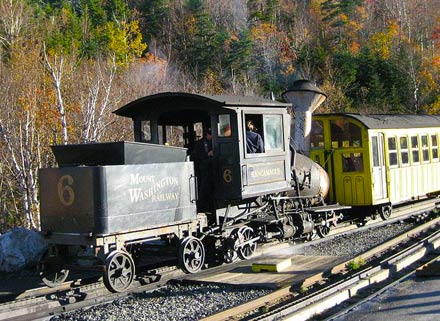
In the 1960s, when Dr. Harry McDade was Chairman of the New Hampshire Medical Society’s Committee on Emergency Medicine, he developed a hospital-wide Disaster Plan. This plan was acutely tested when the tragic Cog Railway accident occurred on Sunday, September 17, 1967. Littleton received 82 critical patients within a six-hour period, all of whom survived. Read Dr. McDade’s personal account of this event [57 KB PDF opens in new tab/window].
The owner of the Cog Railway at the time of this disaster, Ellen Teague, thought that some good came of these tragedies. To quote Ellen in reference to Dr. Harry McDade’s draft Disaster Plan, “That night of the accident he was able to apply his idea. It was so simple and so effective! One doctor would call four physicians, each of those four in turn would call four, and so it went and it worked.” Nowadays, this process is known as a “chain call-out mechanism.” Very soon thereafter, Littleton Hospital reviewed the hospital’s response to the Cog Railway disaster and formalized the Disaster Plan.
Doctors began arriving at Littleton Hospital within two minutes of their phone calls. They waited at the hospital, as there was no radio communication between the hospital and the site of the accident. An estimated 30 ambulances sped to the accident site as well as vehicles from Ross and Pillsbury Funeral Homes and fire departments from all over the North Country. Because of the accident location (near the summit of Mt. Washington), it took nearly two hours to move the injured to the base of the Cog Railway. The US Forest Service and volunteers from the Cog Base Station were on hand at Littleton Hospital to help as needed. Littleton Hospital’s team of volunteers helped, as well. Tom Ross’ words reflect the enormity of this casualty, “To be in the middle of a long line of ambulances with flashing red lights all leaving the Cog and all heading to Littleton Hospital was the most awesome feeling of my life.”
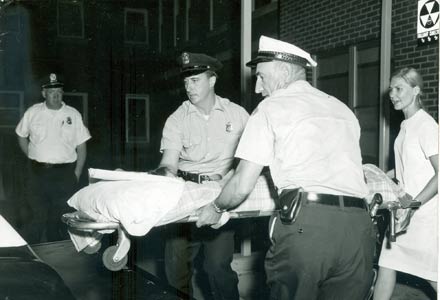
Ambulances began arriving at the hospital at about 8:00 pm on Sunday, September 17, 1967. The emergency facilities were in constant use for the next seven hours. Littleton admitted 11 of the patients and transferred others to regional hospitals closer to their homes. These hospitals included St. Louis in Berlin (now Androscoggin Valley Hospital), Weeks Memorial in Lancaster (now Weeks Medical Center), Morrison Hospital in Whitefield (The Morrison), Mary Hitchcock Memorial in Hanover (Dartmouth-Hitchcock Medical Center), Cottage Hospital in Woodsville, New London Hospital, Barre (VT) City Hospital (Central Vermont Medical Center), and Bright Look Hospital in St. Johnsbury (NVRH). Each of these institutions called in and maintained a staff of emergency workers to assist with the overload that arrived at Littleton Hospital, and received one or more surgical cases requiring immediate attention when other operating rooms were at capacity. All of the patients rescued and brought to the hospitals survived.
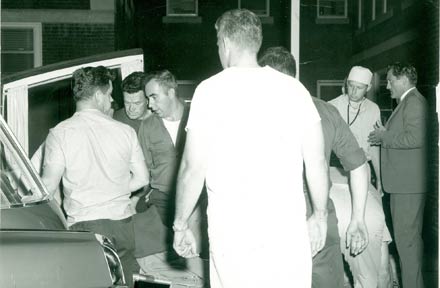
The NH Medical Society praised the near super-human effort and prompt, efficient and effective implementation of Littleton Hospital’s Medical Disaster Plan which saved so many lives after the Cog Railway accident. The Medical Society singled out Dr. Harry McDade as well as Dr. Francis Appleton of Gorham, and all physicians in Coös, Carroll, Grafton, and Belknap Counties who responded to the calls for help. They also cited nurses, ambulance drivers, first-aid persons and hospital clerical and ancillary staffs from Colebrook to the North and Laconia and Hanover to the South, and all places in between. Tom Ross was one of the ambulance drivers transporting many of the injured to Littleton Hospital. One of the primary reasons all of the rescued patients survived was because of the quick response getting the injured to Littleton Hospital for triage and care.
After this crisis, trustees realized that Littleton Hospital was becoming a regionally-serving hospital. The Hospital created an emergency treatment room where physicians on staff rotated to provide medical and surgical coverage.
During the late 1960s the New Hampshire state trauma chairman for the American College of Surgeons (ACS) visited all emergency rooms in New Hampshire’s 27 hospitals, and made constructive suggestions for improvement. To upgrade ambulance and pre-hospital care, they recommended backboards for ambulances to improve outcomes for patients with fractured spines. The majority of ambulances at that time were run by funeral directors.
During this time, Dr. McDade chaired the trauma section of the New Hampshire Chapter, ACS, and continued the efforts begun to upgrade pre-hospital care. “Littleton was a microcosm in trends in emergency medicine,” he said. “We did a lot of ‘firsts’ in surgery north of Hanover.”
In 1968, The American Academy of Orthopaedic Surgeons invited Tom Ross to participate in a pilot Emergency Medical Technician (EMT) course at Harvard University. Tom was one of 300 handpicked individuals from each state in the U.S. invited to attend this course.
Recognizing his leadership abilities, the NH Department of Transportation (DOT) invited Tom to participate in its first NH DOT-sponsored EMT course. Tom later became an instructor for this course, running the first Littleton area course in 1971 at Littleton High School. He later trained future EMTs all across northern NH. Tom also developed a Fast Squad system in Northern New Hampshire, which the region widely adopted in the late 1970’s. This system allowed the sick and injured to be stabilized until the ambulance arrived. To implement the Fast Squad system region-wide, Tom spoke to towns all over the North Country about the importance of having such a system in place. He also assisted the towns in getting grant support for training and equipment.
In the mid-1970s, physicians at Littleton Hospital began running monthly training programs on topics of interest to upgrade skills of emergency room and ambulance personnel. Dr. Richard Monroe, Emergency Room Director for a number of years, along with Drs. Taylor Caswell and Howard Pritham, joined Dr. McDade as members of the course faculty. Having participated in these training programs as a student, Tom Ross played a large role in improving the performance of the state’s ambulance services, sharing his knowledge in pre-hospital care across the region.
Dr. McDade liked to relate the story about how EMS grant monies were first made available. Funding was a result of the federal EMS Systems Act of 1973 when the U.S. Government named a National EMS Director responsible for distribution of the monies nationwide. According to Dr. McDade, who had attended a national meeting in Chicago with the new National EMS Director, he was told that there was no point in having hospitals such as Littleton treat trauma as all of the trauma patients could be flown by helicopter to Hanover. (At the time, National Guard was the only helicopter service. They did rescues; not transfers to healthcare facilities. The DHART service did not begin until July 1, 1994).
After that, Dr. McDade told the EMS Region I officials in Boston that Littleton did not want any of the grant money. Bewildered with this response, the National EMS Director and the Region I Director drove from Boston to meet Dr. McDade in Littleton. They ran into a blizzard and slid off the road in Franconia Notch arriving more than one hour late. They were wet to the knees from pushing their car back on the road. Dr. McDade said he greeted them in the emergency room and said, “When you went off the road, you could have hit a tree and had a ruptured spleen and gone into shock. Would you want to try to get a chopper in here in this storm, and, if you could, which you can’t, would you want to risk the chopper flight to Hanover?” Dr. McDade said EMS officials got the point and the grant monies became available promptly.
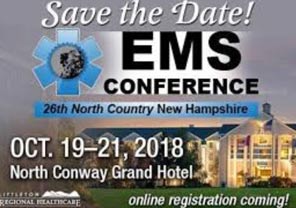
The North Country began piloting this federally funded EMS in 1976. This program had a training and an infrastructure component. Staff and administration of the hospital joined other area health care providers and community leaders to train emergency medical technicians and rescue squad members to become first responders. Since 1993 up until the present day, Littleton Regional Hospital has sponsored an annual Emergency Medical Services Conference. The conference planning committee works in partnership with the Northern NH EMS Council, North Country Health Consortium/AHEC, the NH Department of Safety’s Bureau of EMS, and the NH Department of Health and Human Services. This multi-day annual continuing education event attracts hundreds of attendees from multiple states, due to the expertise of the speakers (many are nationally known) and the relevance of the topics.
The 1975 addition to the Cottage Street campus of the hospital included new Emergency and Radiology Departments, which paved the way for the hospital to become a regional center for emergency care; this upgraded facility was the major reason Littleton was selected to pilot the federal EMS program. On the infrastructure side, the grant equipped community-based teams with radios that allowed the Littleton Hospital to stay in contact continuously with ambulances, emergency vehicles and other hospitals in the region. Also, Littleton Hospital was able to install a federally licensed heliport on this campus to serve the unique needs of aerial evacuation of critically injured patients when the weather permitted.
By the late 1970’s Littleton Hospital named a full-time Director of the Emergency Department (ED). Initially, they staffed the Emergency Department with residents contracted from Hanover and the hospital’s on-call physicians. In the early 1980s, use of the Littleton Hospital Emergency Department increased. Hospital administrators realized that they needed full time staffing of its ED with physicians. Since this time, twenty-four hour on-site physician coverage has been the standard of care in the ED.
By this time, the medical community had recognized Emergency Medicine as a specialty. The hospital’s Emergency Department is staffed around the clock by experienced physicians with knowledge in emergency medicine. Emergency nurses are nationally certified in both emergency and trauma nursing. As a team, the physicians and nurses have the extensive knowledge and experience to quickly evaluate and treat every patient. As a result of the recent renovation/expansion program, the Emergency Department is now positioned to serve the region for years to come.
The New Hampshire Trauma Review Board recognized Littleton Regional Hospital as a Level III Trauma Hospital in 1997. In order to qualify for status at this level, the Hospital needed the capability to admit certain complicated trauma injuries. In addition to trained trauma nurses and physicians, LRH needed facility capabilities in the areas of Surgical Services and Anesthesiology, Radiology, and Clinical Laboratory. Clare Wilmot, M.D. (surgeon), Edward Duffy, M.D. (Emergency Department Director), and Kurt Lucas (Emergency Department Manager-Coordinator) developed the trauma plan necessary for certification as a Level III Trauma Hospital.
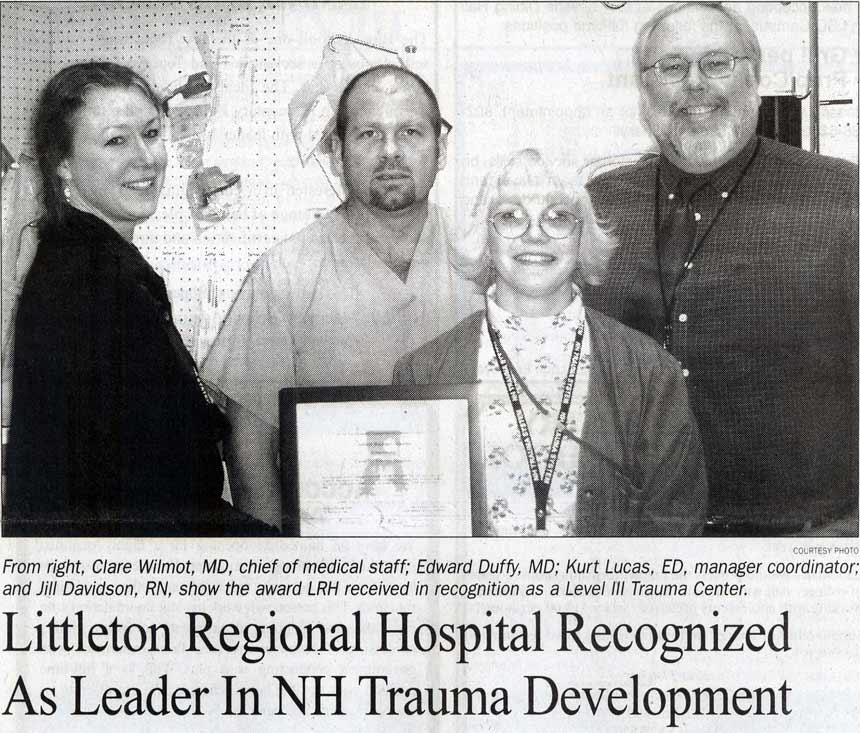
Littleton Regional Hospital started a new paramedic program on February 6, 2001 as a result of receiving a federal grant in the amount of $100,000.00. Paramedics have special training to give emergency medical care to people who are seriously ill with the aim of stabilizing them before they are taken to the hospital. Paramedics are trained to give life-saving care. Given that many of the North Country towns do not have access to the level of care which paramedics give, Littleton Regional was able to get a fully equipped paramedic intercept vehicle with advanced level equipment. When the EMS dispatcher receives a critical call, the paramedic is able to either respond to the site of the incident or to an agreed upon location where the ambulance crew and the paramedic with the intercept vehicle are able to provide the care needed until they get to the hospital emergency room. This program ran until 2013.
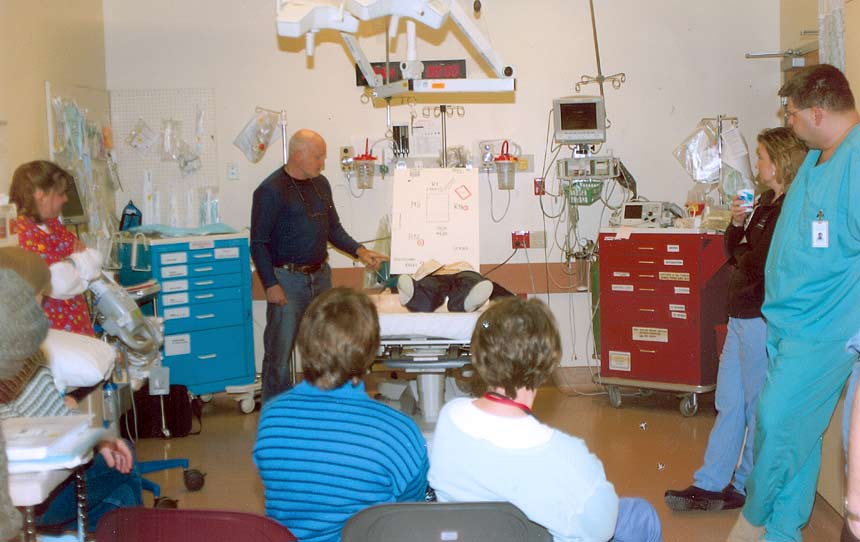
With advances in prehospital care, search and rescue organizations also play a key role in a hospital emergency department’s ability to provide first class care. These volunteer organizations are particularly important in the Littleton Hospital service area, which includes the White Mountains, where many take advantage of outdoor activities year-round.
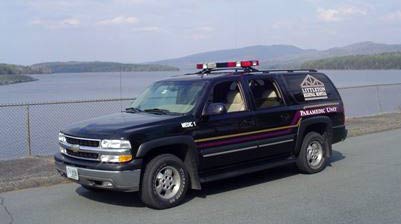
The federal grant in 2001 also included funds to provide more training for those professionals involved in rescues in the environment; particularly treatment of patients with hypothermia. In the Littleton area, the Pemigewasset Valley Search and Rescue Team (PFSART), founded by Allan Clark in 2005, responds to requests from the NH Fish and Game and other public safety agencies. They assist with searches for lost or missing persons, operating primarily in Grafton County and the western White Mountains. The PFSART and other like organizations function as a team along with the EMS prehospital community to give the rescued the best possible chance of a full recovery once they reach the hospital.
Today, Littleton Regional Healthcare’s Emergency Services consists of an integrated team giving urgent or emergent care to seriously ill or injured persons. The team consists of Board-Certified Emergency Medicine physicians, mid-level clinicians, and registered nurses with advanced certifications. Specialty consultation is available, as well. If the team determines that injuries or illnesses are beyond the scope of care at Littleton Regional Healthcare, transports to other facilities are carefully arranged, and use either ambulance or air transport. The team treats over 9,000 adult and pediatric patients each year. Also, Littleton Regional Healthcare’s Emergency Department continues its training roles, hosting nursing students on clinical rotations as well as all levels of EMTs, and planning and co-sponsoring a regional EMS conference each year.
Sources:
Ellen C. Teague, I conquered my mountain, (Courier Printing Company, 1982), 110-115.
Union Leader (September 18-21, 1967) and Littleton Courier (September 21, 1967, March 23, 1997) (Newspaper clippings courtesy of Jean McLean, Franconia, NH, whose mother was a nurse at Littleton Hospital and was present at the time of the Cog Railway accident)
Interview, Tom Ross, February, April 2019
Interview, Campbell McLaren, M.D., March, 2019
Retrieved on 3/8/2019 from https://www.dartmouth-hitchcock.org/dhart/dhart_history.html Wikipedia. Retrieved June 6, 2019, from https://commons.wikimedia.org/wiki/File:Mount_Washington_Cog_Railway_Kancamagus.jpg#file
Caledonian Record (March 16, 2005)
